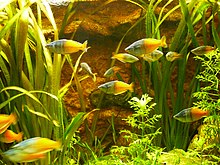Harlequin rainbow fish
| Harlequin rainbow fish | ||||||||||||
|---|---|---|---|---|---|---|---|---|---|---|---|---|

Harlequin rainbow fish ( Melanotaenia boesemani ) |
||||||||||||
| Systematics | ||||||||||||
|
||||||||||||
| Scientific name | ||||||||||||
| Melanotaenia boesemani | ||||||||||||
| Allen & Cross , 1980 |

The harlequin rainbow fish ( Melanotaenia boesemani ), also known as the magnificent rainbow fish , Boeseman's rainbow fish or coral rainbow fish , is an ornamental freshwater fish from the Vogelkop Peninsula in New Guinea .
features
The color pattern of adult male harlequin rainbow fish is very different from that of other rainbow fish: the head and front part of the body are bluish, while the fins and the rear half of the body are bright orange. There are alternating light and dark vertical stripes at the transition between the two color zones. Females often have a greenish tinge and a wide, dark stripe along the middle of the body, which is flanked by thin orange longitudinal stripes between each row of scales, especially in the area of the rear half of the body. Adult females often resemble half-grown, subordinate males in color, but are slimmer and have rounded fin tips. The males have a higher build and reach a body length of about twelve centimeters, the females remain somewhat smaller.
Occurrence
The harlequin rainbow fish occurs in clear waters on a karst level in the center of the Vogelkop Peninsula in West Papua . There he lives locally in the Ajamaru Lakes and surrounding tributaries as well as in the Aytinjo Lake, which drain into the Kais River.
The Ajamaru Lakes consist of three larger, shallow individual lakes with muddy banks that are connected by many natural channels. The water depth and size of the lake fluctuates significantly with the seasons. The ground is muddy and in places overgrown with lush underwater vegetation.
Aytinjo Lake, located about 20 km southeast of the Ajamaru Lakes, is more of a wide river with rocky banks that suddenly ends, but is probably connected underground to the Kais River. The ground is partly rocky, partly sandy with lush underwater vegetation.
In 1980 Gerald R. Allen and Norbert J. Cross described the specimens collected by a Dutch expedition in 1954/1955. In 1982, Allen and Heiko Bleher collected the first live fish that came to Europe through Bleher. The species was last evaluated by the IUCN in 1996 and classified as “critically endangered”.
Aquarium keeping
The harlequin rainbow fish can be kept in water with values of 5–25 ° dH ( GH ) and a pH value of 6.5–8.1 at temperatures of 24–26 ° C. The breed is quite easy, being spawned in a clump of Java moss. What is striking is the extremely slow growth of the fish, which may not be fully grown until 1.5 years of age. If kept well, they can reach an age of over 8 years and a length of over 15 cm.
Socialization with other peaceful fish of the same size is easily possible in a sufficiently spacious aquarium.
literature
- Allen, GR and NJ Cross (1980). Description of Five New Rainbowfishes (Melanotaeniidae) from New Guinea . Records of the Western Australian Museum 8 (3): 377-396.
- Heinrich winner: rainbow fish. The genus Melanotaenia . Natur und Tier-Verlag, 2010, ISBN 978-3-86659-154-7
Web links
- Melanotaenia boesemani on Fishbase.org (English)
- Adrian R. Tappin: Boeseman's Rainbowfish on Home of the Rainbowfish (English)
- Melanotaenia boesemani inthe IUCN Red List of Threatened Species 2013.1. Posted by: Allen, G., 1996. Retrieved October 2, 2013.
